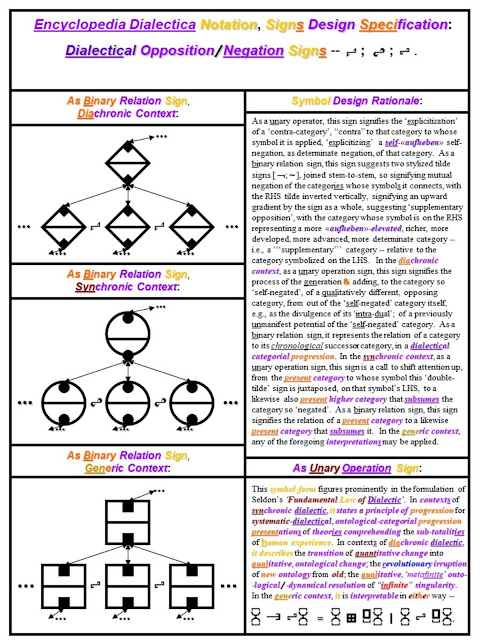Dear Reader,
The F.E.D. generic model of dialectical progressions in general, holds as follows --
Suppose that we have a "sum" of mutually qualitatively different qualitative determinations, collectively denoted by Hh, characterizing a given system, as of step h in the dialectical presentation / systematic dialectic of that theoretical system, or as of epoch h in the self-presentation / historical dialectic of that natural system, where h is a discrete variable ranging over the "Whole" Numbers, { 0, 1, 2, 3, . . . }.
If that "sum" of characteristics is a qualitative, heterogeneous [or inhomogeneous], irreducible, and non-amalgamating, or <<asumbletoi>> [Plato: unaddible] sum, then stage h+1 will exhibit the following, expanded non-amalgamative sum, with additional possible determinations/characteristics describable as follows --
Hh ---> Hh+1 = Hh "of" Hh = Hh(Hh) = ~(Hh) = Hh x Hh = HhHh =
-- such that the term Delta(Hh) "contains" all of the revolutionary, new "ontology" -- all of the newest possible determinations / characteristics -- all computed from the old determinations / characteristics of stage h.
For example, if h = 1, and if the possible features of the maximal natural system known as the cosmos, as of that epoch, epoch 1, are --
( n + s ) = ( sub-nuclears + sub-atomics ) = ( bosons & non-composite fermions + hadrons )
-- such that the underscores indicate the "contra-Boolean" computational logic exhibited by these terms as [dialectical] logic elements, or as [dialectical] logic symbols [i.e., x^2 ~= x], then, as of the next discretely representable epoch, epoch h + 1 = 1 + 1 = 2, the possible features of the cosmos are "predicted" by the F.E.D. "Dialectical "Theory of Everything" Equation" to be --
H1 = ( n + s ) ---> H2 = ( qn + qs + qsn + qss ) = H1 "of" H1 =
( n + s ) "of" ( n + s ) = Hh(Hh) = ( n + s )(( n + s )) =
~(H1) = ~( n + s ) = H1 x H1 = ( n + s ) x ( n + s ) = H1H1 =
H1^2 = ( n + s )^2 = H1 + Delta(H1) = ( n + s ) + Delta( n + s ).
= ( n + s) + (qsn + a ) = ( n + s + qsn + a ) = H2
= ( sub-nuclears + sub-atomics + real subsumption of sub-nuclears by sub-atomics + atomics )
= ( sub-nuclears + sub-atomics + sub-atomic / sub-nuclear hybrids + atomics ).
Note especially the "sub-equation" extracted from the original serial equation above --
Hh(Hh) = ~(Hh).
Its Left-Hand-Side [LHS] expression, read off as "Hh of Hh", denotes the "self-function[ing]" of Hh, that is, the "self-movement" of Hh -- the "autokinesis" [Plato] of Hh.
Its Right-Hand-Side [RHS] expression, read off as "[dialectical] negation of Hh", or as "[determinate] not Hh", denotes the dialectical, determinate negation of Hh, that is, the <<aufheben>> negation of Hh.
So, the sub-equation --
Hh(Hh) = ~(Hh)
-- asserts that the dialectical, determinate, <<aufheben>> negation operation symbol, for a given system-characterization symbol, generically denoted by Hh, itself formulated as a function / operation / action / activity, is, precisely, itself --
~ = Hh [for Hh]. What more determinate, specific, negator could there be, for Hh, than Hh itself?
That is, the effect of the inherent, immanent, "intra-duality", or "self-duality", of such a system, as of stage h in its [self-]development, denoted Hh -- the "internal dialectical contradiction" or "dialectical self-contradiction" of / immanent to that system -- can be expressed as a dialectical, determinate, <<aufheben>> self-negation of that system-stage --
Hh ---> ~(Hh) = Hh(Hh) = Hh x Hh = HhHh = Hh^2 = Hh + Delta(Hh) = Hh+1.
[Note that ~(Hh) = Hh(Hh), so ~(~(Hh)) = ~(Hh+1) = Hh+1(Hh+1) =
Hh^2(Hh^2) = Hh^4, not ~(~(Hh)) = Hh(Hh(Hh)) = Hh(Hh^2) = Hh^3.
That is, the "tilde" symbol, '~', acts like a pair of "horizontalized" ditto marks].
The series of equations --
Hh ---> ~(Hh) = Hh(Hh) = Hh x Hh = HhHh = Hh^2 = Hh + Delta(Hh) = Hh+1
-- expresses the core breakthrough discovery of F.E.D. in achieving the first algebraic representation of dialectical processes in general, the first algebraic dialectical logic --
http://www.dialectics.info/dialectics/Dialectic_Ideography_files/5_Dialectics-Part1b-WhyDI_OCR.pdf
-- [F.E.D., Dialectical Ideography, Prolegomena, Part I.b., pages I-73 through I-75].
F.E.D. thus achieved, in 1999 [or even as early as 1996, judging from the day-counter in their document version-numbers], for algebraic dialectical logic, the counterpart and <<surpassement>> of what Leibniz, from 1666 [though he did not publish his algebra of logic], and Boole, from 1847 [who published, in that year, his booklet entitled The Mathematical Analysis of Logic: Being an Essay towards a Calculus of Deductive Reasoning], achieved for algebraic formal logic --
Leibniz / Boole: x^2 = x, i.e., 0^2 = 0, and 1^2 = 1.
F.E.D.: x ---> ~x = xx = x^2 = x + delta_x, i.e., for every n in N = { 1, 2, 3, ... },
qn ---> ~qn = qn x qn = qn^2 = qn + delta_qn = qn + qn+n = qn + q2n.
Hh ---> ~(Hh) ---> ~(~(Hh)) ---> ~(~(~(Hh))) ---> . . .
-- which is equivalent to the following self-iteration of dialectical self-negation --
Hh^1 ---> Hh^1(Hh^1) = Hh^2 ---> Hh^2(Hh^2) = Hh^4 ---> Hh^4(Hh^4) = Hh^8 ---> . . .
-- is the process that F.E.D. names "The Dyadic Seldon Function" , which can be succinctly summarized as --
Hh = H0^(2^h).
Regards,
Miguel


No comments:
Post a Comment